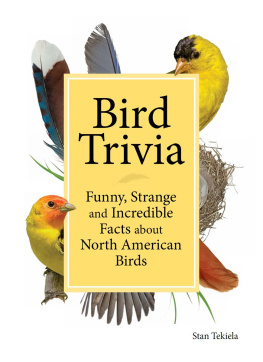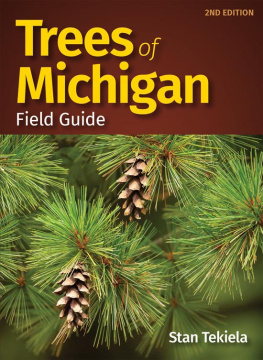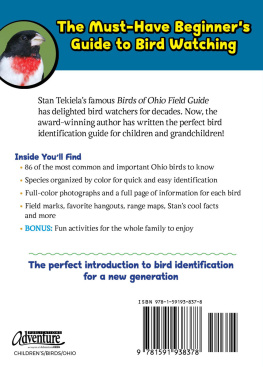

Dedication
To my brothers, Ritch, Ken, Matt and David
Edited by Sandy Livoti
Cover design by Travis Bryant
Interior design by Lora Westberg
All photos by Stan Tekiela except pp. from Shutterstock
10 9 8 7 6 5 4 3 2 1
Bird Trivia: Funny, Strange and Incredible Facts about North American Birds
Copyright 2018 by Stan Tekiela
Published by Adventure Publications
An imprint of AdventureKEEN
330 Garfield Street South
Cambridge, Minnesota 55008
(800) 678-7006
www.adventurepublications.net
All rights reserved
Printed in U.S.A.
ISBN 978-1-59193-810-1 (hardcover); ISBN 978-1-59193-811-8 (ebook)
TABLE OF CONTENTS

Lazuli Bunting
THE MAGNIFICENT WORLD OF BIRDS
Birds are amazing creatures that have captured the hearts and minds of people everywhere. From their outrageous shapes and colors to their unique behaviors, birds are endlessly interesting! As a naturalist with more than 30 years in the field studying birds, I still continue to learn new and fascinating things about them.
Whats not to like about a creature that is often brightly colored and sings beautiful songs? And what is more incredible than a birds ability to fly? Birds are the only animals on the planet that have a lightweight coat of feathers. To be light enough for flight, they also have hollow bones and lightweight beaks. In this book, youll discover many hundreds of other strange and wonderful tidbits about birds that youve always been curious to know.
In North America, we have more than 1,100 great species of birds to appreciate. Many hold astonishing North American records, and some also hold world records! Our winged friends are downright extraordinary, and now you can enjoy them weven more with this fun collection of bird facts and light-hearted trivia.


Northern Cardinal

FUNNY BIRD BEHAVIORS
And the Oscar Goes To ... The Killdeer! This eye-catching bird steals the show with its performance of a broken wing display. To draw an intruder or predator away from the nest site, Killdeer parents will fake an injury and flail about, dragging a wing on the ground. When their display leads the threat far enough away from the eggs or young, the parents suddenly become flightworthy and take off. Surprisingly, other birds, such as Snowy Owls, Mourning Doves and plovers, also feign broken wings.

Killdeer
Fights Its Own Reflection Some male birds, such as male Northern Cardinals, are known to fight their own reflections in a window, vehicle mirror or chrome hubcap. It is believed that these males see the reflection as a competing bird and attack it in an attempt to drive it off. Often this aggressive behavior continues for a couple of days, but sometimes it goes on for months at a time!
Anting for Hygiene Some birds perform a highly specialized behavior that may benefit feather health, called anting. After deliberately disturbing an ant mound, the birds will lie down and allow the ants to crawl all over them! Some of these birds crush the ants with their beaks and wipe the bug juices onto their feathers. It is thought that the formic acid discharged in the ants defense acts like an insecticide, helping to eliminate ectoparasites in the feathers. Some believe it also acts like a fungicide or bactericide.
Wheres the Sunscreen? Oddly enough, some birds lie down in the sun and just stay there for a couple of minutes. They choose a sunny spot, spread their wings and tails, open their mouths, and usually close their eyes. This behavior is known as sunning. Many theories attempt to explain why birds do this, but most likely it just feels good.

Ruby-throated Hummingbird
Bathroom Break Time Vultures have a strange and unusual behavior of urinating and defecating on their legs and feet. The action is actually a means of cooling down by way of evaporative cooling. Called urohidrosis, the birds do this during hot weather, when they are overheating. The Wood Stork also does this to keep cool.
Hawking for Food Flycatchers and other birds that mainly eat bugs will hunt flying insects in a technique called hawking. These birds simply perch on a branch and wait for an insect to pass by. When a bug comes near, they quickly dart out to snap it out of the air, and then return to the branch to eat.
Funny thing, Red-headed Woodpeckers do the same exact thing even though theyre not flycatchers, and they dont have a main diet of insects.
Birds Using Tools Some gulls will carry clams or oysters high above the ground and drop them onto rocks to break open the shells. Crows use twigs to fish insects out of cracks and crevices.

Greater Roadrunner
Fearless Snake Hunter The roadrunner uses a bizarre method to hunt venomous snakes. It will fluff its feathers, spread its wings and taunt the snake to strike! The bird tries to keep far enough away so that when the snake strikes, it may only graze the feathers, missing the skin. A roadrunner will make a snake strike three or four times to wear it down or continue to taunt until the striking stops. At that point, the roadrunner uses its large bill as a weapon and strikes the snakes head a couple of times. Afterward, it picks up the snake and whips it around until it is dead.
Killer Songbirds Most predatory birds have strong feet and long, sharp talons to grasp and dispatch prey. Shrikes are predatory songbirds that lack this equipment, but they still capture and kill smaller birds and rodents successfully. Loggerhead and Northern Shrikes, also called Butcher Birds, have long, heavy bills with a sharp hook on the end to do the job. Once they subdue the prey, they usually impale the meal on a stout thorn or barbed wire, where they tear it into small, bite-sized pieces.

Northern Shrike
Preening: More Than Just Cosmetic All birds preen their feathers with their bills and feet to keep them in good condition. Some species, such as Great Blue Herons, Barn Owls and American Bitterns, also have a specialized middle claw with a serrated edge that serves as a built-in comb. These birds use the comb-like edge as a preening tool on their heads to rid themselves of debris or parasites. This special claw is called a pectinate claw, or feather comb.
Next page



























